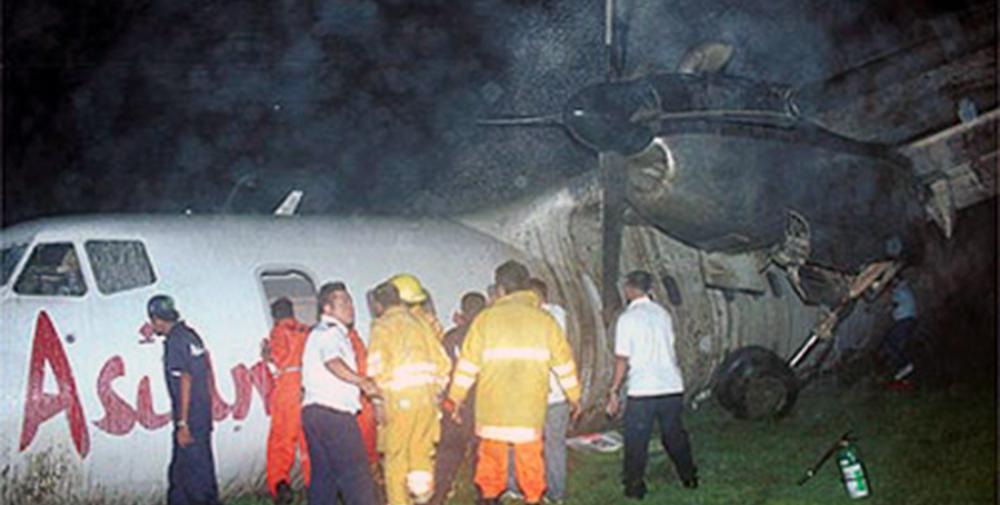Tragedy in the Skies: 8 Deadliest Plane Crashes in the Philippines (in Recent History)
Jun 20, 2025 • Cristina Morales

Jun 20, 2025 • Cristina Morales
Statistics say that you’re more likely to get struck by lightning than be involved in a plane crash. But even with the odds in your favor, stepping onto a plane can still feel like a leap of faith. After all, Philippine aviation hasn’t been spared from tragic events, some claiming hundreds of lives.
Here are the 8 most deadly plane crashes in the Philippines, from the 1970s onwards.
On April 19, 2000, Air Philippines Flight 541, with 131 people onboard, left Manila for Davao City. Around 7 AM, as the plane was getting ready to land at Francisco Bangoy International Airport, the pilots saw another plane still on the runway and told air traffic control they needed to try landing again.
Instead of safely climbing and circling back, the pilots attempted to fly visually in poor visibility at a lower altitude. Sadly, the plane hit a coconut tree about 500 feet above sea level, just a few miles from the airport, crashed, and caught fire. No one survived.

Cebu Pacific Flight 387 departed Manila at 1:00 GMT on February 2, 1998, with a scheduled arrival in Cagayan de Oro at 3:03 GMT after a stop in Tacloban around 2:20 GMT. Reports differ on whether the stop was planned or made to deliver a spare aircraft tire. The last communication with air traffic control occurred 15 minutes before the expected landing, as the pilot reported the plane was 68 kilometers away and descending.
However, the aircraft crashed 45 kilometers from the airport into Mount Sumagaya. The pilots had been flying visually rather than using instruments and may have been misled by fog and outdated maps, which listed the mountain’s height as 5,000 feet instead of its actual 6,000 feet. Speculation also suggests a downdraft contributed to the crash. Tragically, all aboard perished. A memorial was later established to honor the victims.
The Philippine Air Force C-130 crash on July 4, 2021, was the country’s deadliest military aviation disaster. The aircraft overshot the runway at Jolo Airport in Sulu during a go-around attempt, slamming into nearby structures and catching fire. Among the fatalities were 50 soldiers on deployment and 3 civilians on the ground. 54 of the 104 passengers and crew survived. While the exact cause remains unclear, investigators cited potential environmental and aircraft factors complicating landing procedures.
On June 26, 1987, Flight 206 took off from Manila Domestic Airport bound for Loakan Airport in Baguio. The flight was scheduled to land at 11:10 AM, but poor visibility and monsoon conditions were reported as it approached the area. Approximately ten minutes before landing, the plane disappeared from radar. Its wreckage was found five hours later on the foggy slopes of Mount Ugu, roughly 180 meters below the mountain’s summit and 15 kilometers south of the airport. Tragically, everyone on board perished in the crash.

An act of terrorism marked one of the darkest chapters in Philippine aviation history. On April 21, 1970, a bomb exploded in the lavatory of Philippine Airlines Flight 215, a Hawker Siddeley HS-748. The explosion caused the aircraft to break apart mid-air, killing all 32 passengers and four crew members. This tragic event highlighted the need for stricter airport security, which was relatively lax at the time.
On May 11, 1990, a Beechcraft 1900C plane, Flight 075, crashed into a house shortly after taking off from Manila’s airport. During takeoff, the right engine failed, and the plane turned sharply as the crew tried to head back. The aircraft couldn’t climb higher than 400 feet and hit a house in a Paranaque subdivision. Everyone on board, all 21 people, died, along with a family of four in the house, including two children aged 1 and 4.
Investigators found that the crash occurred because the pilot was unable to maintain control of the plane after the engine failure, partly due to a problem with the engine itself. Witnesses reported seeing smoke coming from the right engine before the crash.

Laoag International Airlines Flight 585 took off from Manila’s airport early in the morning, heading to Basco, Batanes. Shortly after takeoff, both engines began to fail. The crew tried to return to the airport but couldn’t, so they attempted a water landing in Manila Bay. The plane broke apart and sank to a depth of 60 feet. Despite rescue efforts, 19 people died, though a few survived, including the pilots and a bishop.
Investigators found that the crash occurred because the pilots didn’t notice that the fuel valves were closed, which caused the engine failure. It was also revealed that the airline wasn’t allowed to run scheduled flights and that the captain might have submitted fake training documents. These serious issues led to legal actions against the airline and ultimately to its shutdown.

On December 7, 1999, Asian Spirit Flight 100, a small Let L-410 plane, crashed into a mountainside in the Philippines while flying from Manila to Cauayan, Isabela. The plane lost contact with air traffic control shortly before its scheduled landing, and tragically, all 15 passengers and two crew members were killed. The exact reason for the crash remains unclear. The wreckage was found the next day in steep, rugged terrain, showing how dangerous flying small planes in tough conditions can be.
When you hear about these incidents, does it change the way you think about flying? Sound off in the comments to let us know!
Though a chronic dabbler in whatever tickles her fancy, Cristina claims she can count her passions on one hand: feminism, literature, the environment, embroidery, and the power of a solid pop song. She lives in Uniqlo lounge pants and refuses to leave the house without a winged eye.


Input your search keywords and press Enter.
